GENESIS OF BACTERIAL INFECTION – STRATEGIES OF SURVIVAL-INTER-CONNECTEDNESS.
When bacteria through bleeding gums enters the bloodstream, it is immediately detected by the immune system of the host and full mobilization of the defenses is implemented and a frontal attack of the immune system is launched. The bacteria are fully aware that they have entered the hostile territory and their presence has been detected. They immediately begin the evasive actions of outmaneuvering and outsmarting the immune system’s defenses. The welcome party of immune T-cells will detect the bacteria and mark the cellular membrane with a specific marker which will allow the macrophages to recognize and devour the invaders. The bacteria know that they are marked and will be destroyed, so they will sacrifice their cellular membranes and escape. Through extensive research and advances in molecular biology we have gained understanding of these strategies and now we are fully aware that in many instances these bacteria are very successful and pathogens can colonize and master the invaded territory of the host, manifesting in form of chronic diseases.
Professor Linda Mattman of the Wayne State University and her colleague Dr. Phil Hokstra in their research discovered that the microorganisms when challenged shed their cell walls which makes them less vulnerable in this form. They then can easily invade and hide in the body’s own cells. This strategy is very common in nature. For example, lizards when challenged by the predator will drop their tail which will successfully confuse the predator and allow the rest of the body to escape to safety.
The enigma of predator and prey relationship is a revelation in itself when we start paying attention to the logistics of the phenomenon. By utilizing our faculty of reason we will dissect the complexity of the relationship between the predator and prey.
Lion and Zebra. 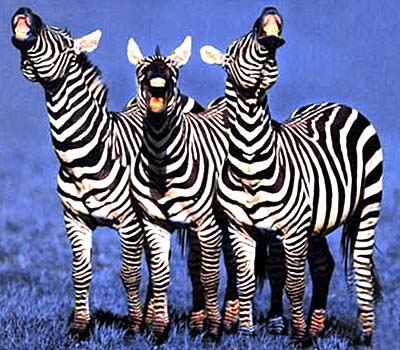
In principle the predator wants to be as close as possible to its prey. This has been expressed in many fairytale stories in our culture like “Little Red Riding Hood.” On the other hand, the prey wants to be as far as possible from the predator, and only when there is contact between them, it ends the same way as the story, the prey gets eaten. The essence of life and survival is to gather intelligence of the enemy. That knowledge when converted to strategy will become the difference between life and death. How does the zebra know that the lion’s vision is in black and white only? This intelligence is incorporated into the strategy utilized on the genetic plane. The gene responsible for black pigment in the zebra’s hair has to be expressed, then the gene for white pigment, as well as the gene for pattern formation. So in the end we end up the familiar pattern of black and white stripes characteristic of zebras. The pattern is emphasized by utilizing the highest possible contrast of black and white. This strategy will work only when combined with the behavior of the whole herd of animals when they are in motion. The rapid jerky movement from left to right of the whole herd in synchronized rhythmic fashion will confuse the lion’s brain for few seconds, and this is sufficient to gain the distance of safety for the herd.
This strategy is very common among species: herds of animals, flocks of birds, schools of fish, and the motility of planktonic form of bacteria in aquatic environment. The puzzling question remains: what sensors are capable of gathering, storing and transforming this information? Do they really exist? Are they really necessary? Not according to the Bell’s theorem (John Bell the Irish physicist, in a theorem which was formulated in 1964). It holds that the reality of the universe must be nonlocal; which means all objects and events in the universe are inter-connected with one another and respond to one another’s change of state. Inter-connectedness is accepted as a ruling principle, along with many forms of symmetry that extend through universe.
This information is traveling faster than the speed of light, that’s why the change of spin in one subatomic particle causes an equal but opposite change instantly in its partner somewhere in the universe. The English astronomer Sir Arthur Eddington once said, “When the electron vibrates the universe shakes.” All this is elegantly summarized by Deepak Chopra in his statement:
“The material body is a river of atoms, the mind is a river of thought, and what holds them together is a river of intelligence”.
Thought generated by the human brain is a substance. The strongest ones that are created will take the final form of an electromagnetic wave which, once created, will last forever and is indestructible. This is our eternal signature which is broadcast outward to the universe throughout our lifetime, to be finally followed by our immortal consciousness.
CHALLENGE OF THE ENVIRONMENT
When the bacteria enters the human blood vessels, there is a dramatic change of the environment in a very short time. The new environment inside the invaded human cell will put tremendous stress on the newly created micro bacterium. The metabolism of bacteria which obended it cellular form, will slow down 400 times compared to its previous cellular form, but it will not stop the micro bacterium, which will adapt to the challenges and will start multiplying inside the invaded human cell. The toxicity levels of these spontaneous mutants are extremely high compared to their cellular form.
Featured in Academia News: “Bacteria after invading healthy cells are able to camouflage and build a home for themselves inside the cell, and cause disease by manipulating natural cellular processes, by altering the host proteins in order to divert raw materials within the cell for use in building and disguising a large structure to house bacteria when replicates. The bacteria is stealing material from the cell to build their own house and then disguising it so it blends with neighborhood.”
Let’s pause for moment and scrutinize this research summary. What information is being conveyed here? I propose to take this information one piece at the time: The parasitic infectious bacteria invades the human mouth by modulating the behavior of the previous host, which helps them with the transmission process. Then that starts the matrix and bio-film formation, and the established colony prepares the ground for invading the bloodstream of the host. Then once inside, they shed their cellular membrane, invade the healthy human cells and then start stealing materials from the invaded cell to build their own colony, disguised as natural cell structures and they begin multiplying.
What all this really means is that this pathogen is possessing a polymorphing characteristic and superior intimate knowledge about the processes and physiology of the environment of the human body. Their ancestors have been there before thousands of times; the mission is prepared to the last detail. Nothing is left to chance. You cannot eject the pilot from the jet plane without first designing, building and testing the catapulting device and anticipating the condition for its use. The bacteria have their catapulting device working perfectly, as well as hundreds of other capabilities built in to its genetic pool, aiding them in their life cycle as the micro-parasite at the molecular level of the human body.
The cell will get bigger like a balloon, pregnant with multiplying micro bacterium circulating inside the vessels of the human body. It is waiting to be discovered and put under a microscope of the researcher who will photograph it and label it as a “ Giant Russell Body.” The cell eventually will burst, releasing its deadly content which will circulate in the bloodstream, invading other healthy cells. This time they will be called a “Micro Russell Body.” It is a well-known fact that Russell Bodies can be found not only in cancer but in the majority of inflamed tissue throughout the body. They are also prevalent in the pulpitus of the teeth with histological features of chronic inflammation. Some of these pleomorphic (form-changing) bodies go through 16 stages of metamorphosing changes, which has puzzled researchers, and could very well be a development cycle of micro parasiting (dependence of one living organism on another), where the invader goes from host to host or cell to cell, in and out throughout its life cycle.
Nature is full of examples of parasitic relationships.
THE RESEARCH
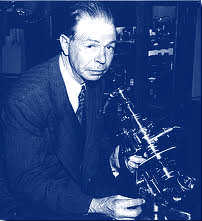
Royal Rife
Royal R. Rife cultured an organism from tissue taken from human breast cancer, and then injected the microorganism into 412 healthy rats and found that all of them developed breast cancer. Then he was able to isolate the original microorganism from tumors, which grew in the rats. Probably he was the first researcher ever who fulfilled “Koch’s Postulate” for cancer causing microbes.
The work of Edward C. Rosenow, M.D. (head of Division of experimental bacteriology and professor of experimental bacteriology for the Mayo Foundation from 1915-44).
Early in his career, Rosenow worked closely with Frank Billing and Charles H. Mayo, both former AMA Presidents and staunch advocates of the concept of oral focal infection as a key factor in human systemic disease. And another former AMA President, Walter Bierring, in a landmark article discussing the works of Billings and Rosenow in the authoritative Journal of the American Medical Association (JAMA) in 1938, cited independent results that “furnished definite confirmatory proof of Rosenow’s theory of elective localization”. “Rosenow’s work has been so scientific, and his facts so firmly established that I believe we must either repudiate his facts, or in general way accept his conclusion… in regard to the elective affinity of bacteria for different organs and structures”. (George W. McCaskey in A.R. Barens and A.S. Giordano, Journal of Indiana State Med. Assoc., Ja. 15, 1922, 5.). Frick (A. Frick, JAMA 82:595, Feb. 23, 1924) stated that according to his clinical experiments there seems to be no doubt that Rosenow’s theory of the elective affinity of a specific streptococcus… for the gastric and duodenal mucosa is correct and the specific streptococcus is the common cause for peptic ulcer.”
Dr. Rosenow conducted eleven thousand experiments on animals by securing organisms from focal infections of the human mouth, usually infected gums from patients suffering from variety of systemic diseases, then culturing them and inoculating animals, reproducing the clinical syndromes of the patients in the animals. Resemblance of symptoms was often unbelievable. One of the important observations of Dr. Rosenow was that anaerobic strains of pathogenic bacteria were highly sensitive to changes of the oxygen partial pressure in their environment. “Rosenow…demonstrated in his laboratory experiment on a single rabbit which was infected with material from a patient who had died under violent encephalitic hiccups. Already 48 hours after the injection, the animal died in front of the visitors eyes after having hiccoughed violently for several hours.
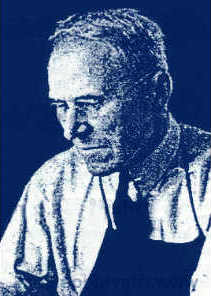
Dr Edward C. Rosenow
The paramount work of Dr. Rosenow was fraudulently suppressed; if you have further interest in his revealing work I refer you to two publications by S. Hale Shakman from Institute of Science “Reference Manual Rosenow and All” and “Medicine’s Grandest Fraud PhD”. In 1924 it was known that peptic ulcers are caused by bacterial infection yet the treatment modality completely ignored the underlying true causes proscribing invasive surgical procedures to treat bacterial infection.
It took 60 years, up to 1984 when Barry Marshal and Robin Warren, after their second try, were accepted by Lancet to publish their discoveries. They isolated the bacteria responsible for 90% of duodenal ulcers and up to 80% of gastric ulcers, named Helicobacter Pylori. The bacteria is a spiral shaped gram negative Microaerophile, which requires a lower level of oxygen (~ 20% of existing atmospheric level). The infection is typically contracted in early childhood frequently by transmission from mother to the child, and that bacterial infection may remain for the rest of the person’s life. To prove the point to the world, on June 12, 1984 Barry Marshal intentionally publicly consumed H. Pylori and became ill, than he took antibiotics and was relieved from the symptoms, essentially proving conclusively that stomach ulcers are nothing more than a bacterial infection.
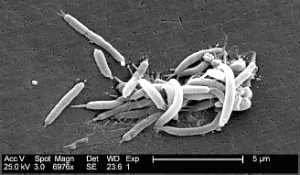
Helicobacter Pylori
In July 31, 1984 the New York Times published an article by its medical correspondent Dr. Lawrence K. Altman on the possible link between H. Pylori and (PUD) peptic ulcer disease. Dr. Altman stated later in 2002 “I never seen the medical community more defensive or more critical of a story” since he joined the newspaper in 1969. The largest resentment usually came from those in authority and those who made the biggest money on the procedures which became obsolete over night. In 2005, Barry Marshal and Robin Warren jointly received the Nobel Prize in Physiology or Medicine; this permanently stopped further discussion from the opposition.
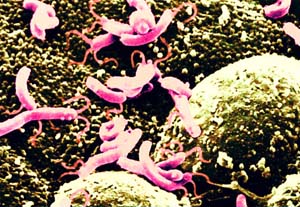
Heliobacter pylori and imune T-cels (large spherical shapes)
“Once humankind’s conventional mentalities form a systematic way of working and thinking, new ideas are very difficult to accept. When the truth finally emerges, people do not believe it and instinctively reject it. Some people have developed the stubborn notion that only what one can see through the eyes is real and concrete. They do not believe what they cannot see, yet your eyes cannot see the truth when they are being deluded by false impressions.” This attitude has allowed them to function utilizing less than 5% of the brain’s capacity. Albert Einstein mastered 15%.
STRATEGIES OF SURVIVAL
The other well-documented strategy of bio-film fragments that enter into the bloodstream is that they will release chemicals which activate platelets to unite and create a shield that blankets the bacteria, protecting them from detection by immune cells and antibiotics. This irregularly shaped newly created body will circulate in the bloodstream until it finds a suitable location to establish a new colony of bio-film in body tissue or organs, but in the mean time it will be a “Russell Body”.
All these findings support Rosenow’s theory of elective localization. The research on Bacillus Anthracis supports the findings that when the clusters of bacteria form, through quorum acting they will activate coagulation factors which will initiate blood clots formation. (Nature Chemical Biology Nov. 2.2008). The bacteria, after dropping its cellular membrane, will utilize the strategy of coating itself with hydroxyapatite cocoons, which the immune system recognizes as calcium and leaves them alone. It is a simple strategy, requiring only a change of electrical charge to become automatically coated with ionic calcium present in the blood-stream.
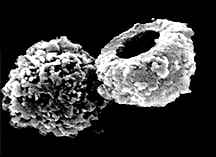
Nanobacteria or Calcified Nano Particles (CNP)
This form of calcified microbacterium was discovered in 1988 by Nobel Prize nominee Dr. Neva Ciftcioglu who named them “Nanobacteria.” Nanobacteria or Calcified Nano Particles (CNP) are noted for being an active direct cause of pathological calcifications in human tissues. CNP are capable of bio-film formation similar to regular bacteria /Mayo Clinic Sudy/. There are indications that both enzymatic and physical-chemical interactions are required for bio-film formation. Tetracycline, an antibiotic that acts by blocking ribosomal protein synthesis but also has calcium chelating activity, is more effective in reducing nonbacterial bio-film than gentamicin which also acts to block bacterial ribosomal function, but lacks significant calcium chelating properties.
Our food production relies on industry standard “Pasteurization.” The process of pasteurization can be described in four words: the temperature too high, the temperature too low, which means the temperature is too high if it denaturizes the proteins and is too low if it does not eliminate all the pathogens, not mentioning the spores. The county statistics are overwhelmed with reports of poisoning by pasteurized foods.
Let’s review what we know about bacteria. Bacteria exist in two basic forms “Planktonic” and “Bio-film.” The planktonic form was described by Antoni Van Leeuwenhoek in 1673. Is a single cell motile organism living in a fluid aquatic environment capable of rapid movement known as motility? The research of the last two decades shows that planktonic mode of growth is secondary to the adherent type of growth typical to bio-film. Most of the knowledge of microbiology is based on work using free-floating organisms of the planktonic form. Unfortunately they represent only very small percentage of all bacterium and again an even smaller percentage of pathology associated with them. The cellular membrane surfaces of these organisms are hydrophiling (water lowering) and the pattern of gene expression is a markedly 30% different from bio-film bacteria. They coat themselves with various sugars (called glycocalyx) which will allow them to adhere to surfaces, and they tend to be more susceptible to antibiotics and chemical agents.
If you would like to make a comparison between planktonic form of bacteria and humanity it would be equivalent to the very early state of development of human society on the level of hunting and gathering, with minimal influence on the environment practically living off what nature has provided.
The bio-film on the other hand is a higher order of complexity, a heterotrophic mixed species of bacterium organized through sophisticated communication systems, capable of producing highly effective biochemical substances with engineering capabilities of matrix formation. Again if we would like to compare this form of bacteria to humanity it has to be up to date with latest development of our urban style of living and even then, the verdict of sophistication will be in favor of the bacteria bio-film.
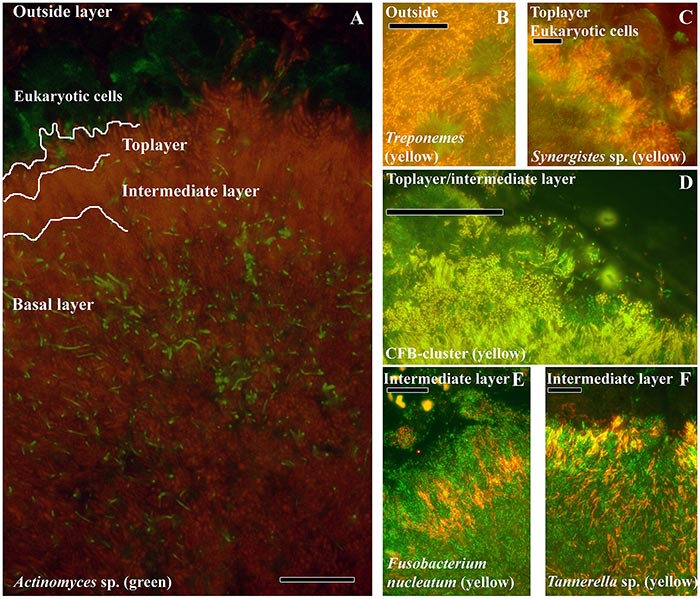
Subgingival bio-film structure, bacterial aggregates.
Photo : (A) Overview of the subgingival biofilm with Actinomyces sp. (green bacteria), bacteria (red) and eukaryotic cells (large green cells on top). (B) Spirochaetes (yellow) outside the biofilm. (C) Detail of Synergistetes (yellow) in the top layer in close proximity to eukaryotic cells (green). (D) CFB-cluster (yellow) in the top and intermediate layer. (E) F. nucleatum in the intermediate layer. (F) Tannerella sp. (yellow) in the intermediate layer. Each panel is double-stained with probe EUB338 labeled with FITC or Cy3. The yellow color results from the simultaneous staning with FITC and Cy3 labeled probes. Bars are 10 µm. ( Courtesy of Vincent Zijnge, M. Barbara M. van Leeuwen, John E. Degener, Frank Abbas, Thomas Thurnheer,Rudolf Gmür,Hermie J. M. Harmsen ).
The engineering capability can be demonstrated by the fact that a matrix can be formed against shear forces that exceeds Reynolds’ by 5000 (Reynolds describe the velocity of turbulent flow of a liquid). This condition exists in the heart and major blood vessels. The matrix formed in areas of high velocity turbulent flow will have the characteristics of high tensile strength, resistant to mechanical breakage, and adequate strength in existing conditions. In low-shear velocity, laminar flow, the tensile strength, will be lower but adequate to existing conditions. The matrix is viscoelastic and behaves in a rubbery manner. Their polymeric structure is 95% water. When the bio-film reaches its maturity, the bacteria, through quorum sensing, can decide to lower the tensile strength of the matrix, allowing for the breakdown of the bio-film and detachment of preformed micro colonies (up to 150 cells of bacterium are needed to retain the capability of the original bio-film.)
The shedding of the micro colonies can lead to a stroke, coronary blockage or severe pulmonary sequels with well-known clinical consequences.
Bio-film bacteria are programmed genomically to live predominantly in matrix-enclosed bio-films in a nutrient sufficient ecosystem and to release planktonic cells only episodically to colonize fresh surfaces. To live in a bio-film community the bacteria have to abandon their mobility to sessile (immobile) existence. There are several benefits provided by the organized society of bacteria. The biggest one is safety. The bio-film is 1000 times more resistant to chemicals and antibiotics and protects the bacteria from the attack of the immune system of the host. There is a system of efflux pumps which can actively eliminate chemicals and antibiotics after their penetration into the cell of the bacteria. There is a system of recognition and preparation of antibodies which will be transported through channels for the benefit of the whole community.
Remarkable parallels exist between the molecular and human forms of criminality. Labile or mutation sensitized proteins can simultaneously convert into an aggregation-prone formation that is toxic and infectious. These hazardous behaviors which can be described as a form of molecular criminality will be neutralized by the molecular chaperone and protease enzymes which are sort of similar to law enforcement agents. Damaging proteins that escape proteazonal degradation can also be incarcerated into dense amyloids evicted from microbial cells and internally recycled. The bacteria can anticipate future events and prepare for them.
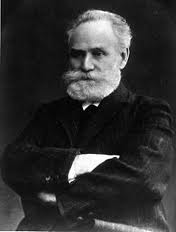
Ivan Pavlov (1849 - 1936)
This finding will collaborate with the research of Ivan Pavlov (1849-1936), the first Russian scientist to win the Nobel Prize. His research was based on both ethical and scientific considerations. In the 1900s Pavlov’s research switched to the central nervous system and conditioned responses. When working with dogs he discovered that dogs started to produce saliva when hearing the footsteps of the laboratory technician, even though no food was present. It was established that a similar mechanism was behind the learning process in both animals and humans. Now this also applies to the bacterium. We can no longer afford not to recognize the fact that we are dealing with highly evolved, sophisticated intelligence capable of utilizing civilization to its advantage for communal survival. The commonality and minimal conflict when combined makes for an optimum level of adaptation to changes of the environment, which is an essence of life and survival.

WATER:
Symbol of unconscious and action; life force of the psyche; rebirth; the source of creation; symbol of life; cleansing and rebirth.
